
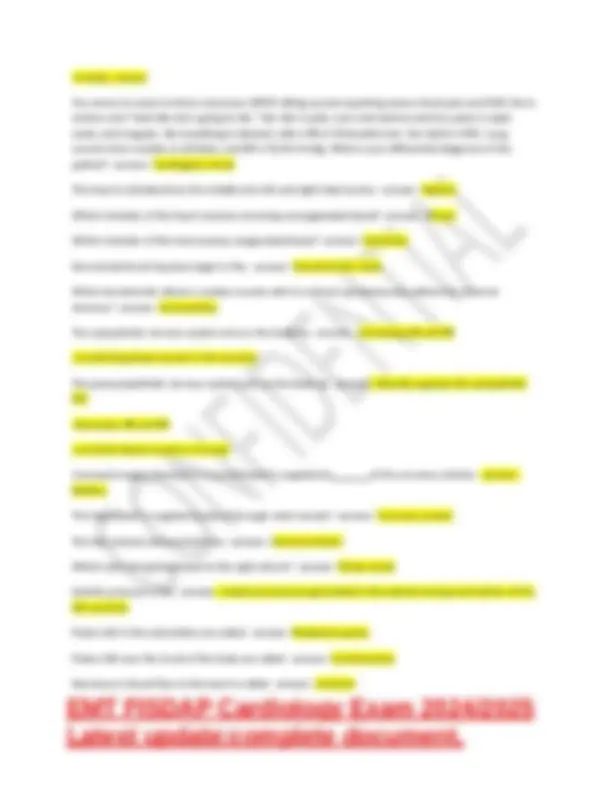
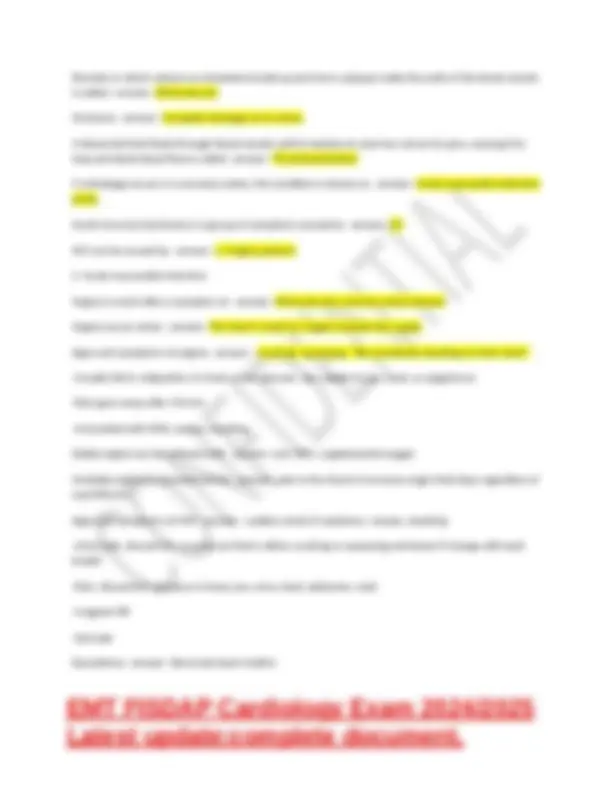
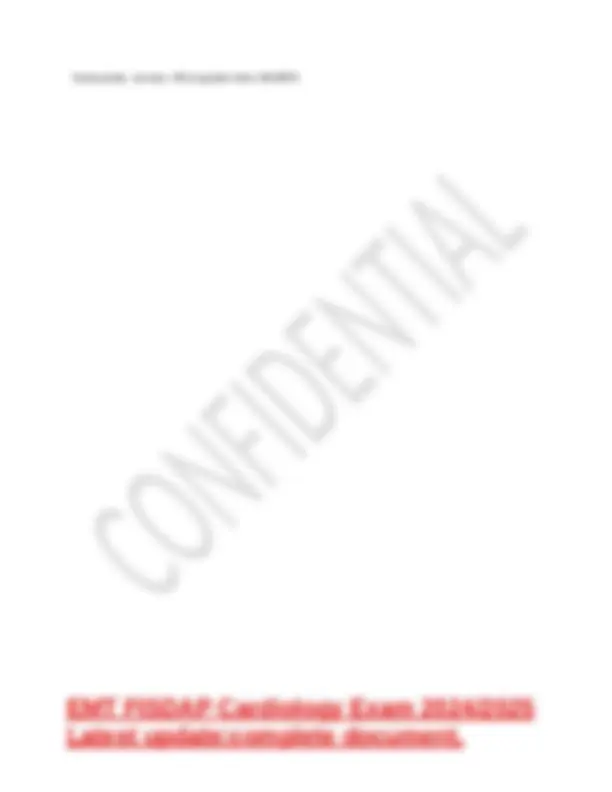
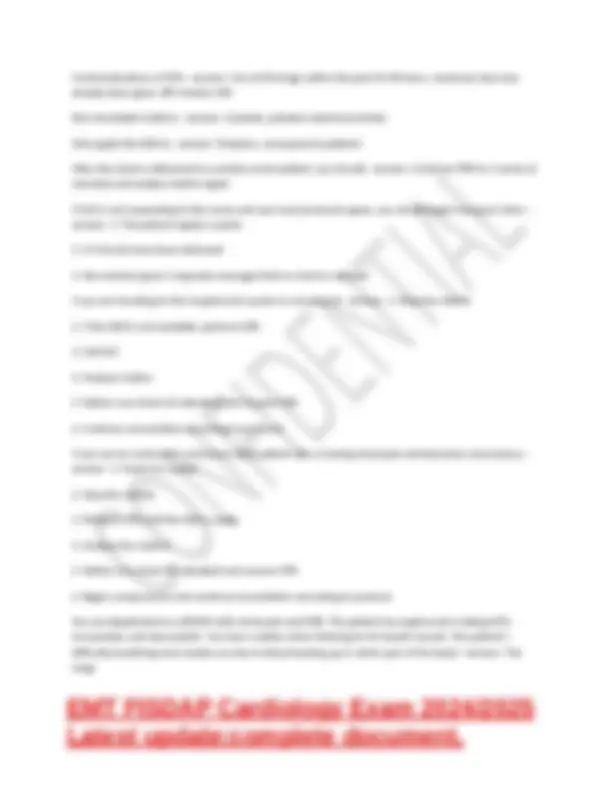
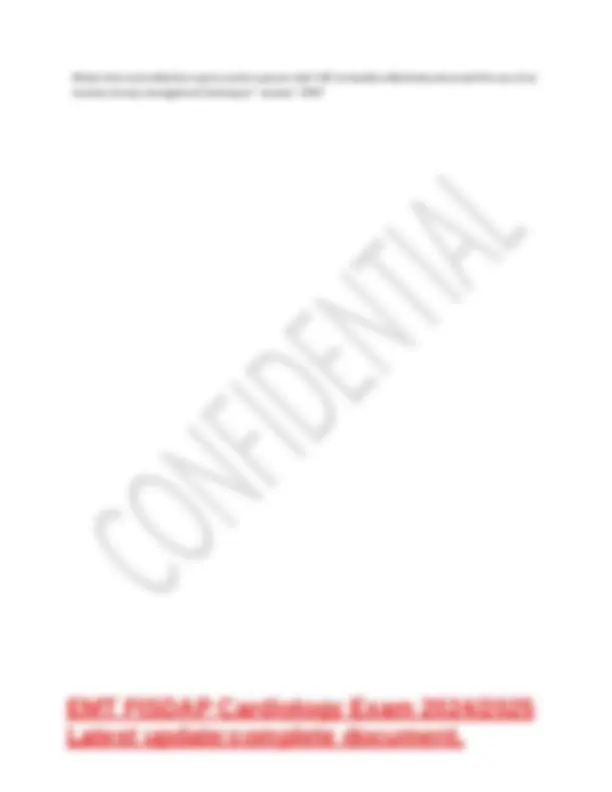
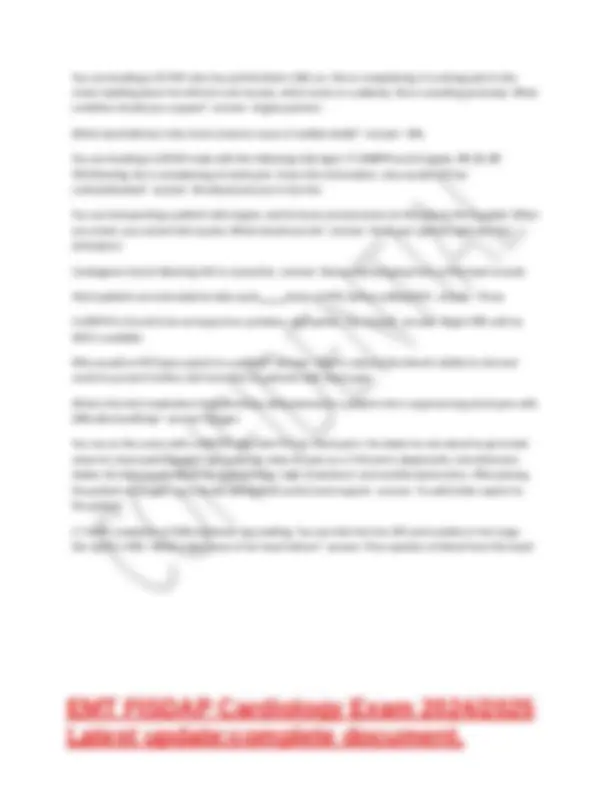


Study with the several resources on Docsity

Earn points by helping other students or get them with a premium plan


Prepare for your exams
Study with the several resources on Docsity

Earn points to download
Earn points by helping other students or get them with a premium plan
Community
Ask the community for help and clear up your study doubts
Discover the best universities in your country according to Docsity users
Free resources
Download our free guides on studying techniques, anxiety management strategies, and thesis advice from Docsity tutors
EMT FISDAP Cardiology Exam 2025/2026 Latest update:complete documentEMT FISDAP Cardiology Exam 2025/2026 Latest update:complete document
Typology: Exams
1 / 10

This page cannot be seen from the preview
Don't miss anything!







Which intervention or interventions would have the MOST positive impact on the cardiac arrest patient's outcome? - answer- Early CPR and defibrillation The AED gives "no shock" message to a patient who is in cardiac arrest. You should: -answer- Resume chest compressions What is the maximum amount of time that should be spent checking for spontaneous breathing in an unresponsive child? -answer- 10 seconds When performing CPR on an adult, you should compress the chest to a depth of at a rate of. - answer- 2.0-2.4 in, 100-150BPM What is the appropriate compression to ventilation ratio for adult two-rescuer CPR? -answer- 30: When checking for a pulse in an infant, which artery should you palpate? -answer- Brachial When performing CPR on an adult or child, you should reassess the patient for return of respirations/circulation every minutes. -answer- 2 What is the preferred method of removing a foreign body in an unresponsive child? -answer- Chest compressions Cardiogenic shock is caused by: -answer- Inadequate function of the heart muscle Pericardial effusion -answer- Collection of fluid between the pericardial sac and the myocardium Cardiac tamponade -answer- Occurs when blood leaks into the space between the pericardium and the pericardial sac Signs and symptoms of cardiac tamponade: -answer- Beck triad: the presence of jugular vein distention, muffled heart sounds, and a narrowing pulse pressure where the systolic and diastolic blood pressures start to merge. Signs of cardiogenic shock: -answer- -Skin may be cool, clammy, and ashen -High BP
-Rapid, shallow breathing -Weak, irregular pulse
Disorder in which calcium an cholesterol build up and form a plaque inside the walls of the blood vessels is called: -answer- Athersclerosis Occlusion: -answer- Complete blockage of an artery A blood clot that floats through blood vessels until it reaches an area too narrow to pass, causing it to stop and block blood flow is called: -answer- Thromboembolism If a blockage occurs in a coronary artery, the condition is known as: -answer- Acute myocardial infarction (AMI) Acute Coronary Syndrome is a group of symptoms caused by: -answer- MI ACS can be caused by: -answer- 1. Angina pectoris
Tachycardia: -answer- HR of greater than 100 BPM
Nitroglycerin action: -answer- Activates the sympathetic NS, relaxes the muscles of blood vessel walls, dilating coronary arteries, increasing blood flow and the supply of oxygen to the heart
Contraindications of NTG: -answer- Use of ED drugs within the past 24-48 hours, maximum dose has already been given, BP is below 100 Non-shockable rhythms: -answer- Asystole, pulseless electrical activity Only apply the AED to: -answer- Pulseless, unresponsive patients After the shock is delivered to a cardiac arrest patient, you should: -answer- Continue CPR for 5 cycles ( minutes) and analyze rhythm again. If ALS is not responding to the scene and your local protocols agree, you should begin transport when: - answer- 1. The patient regains a pulse
You are treating a 50 YOF who has just finished a 10K run. She is complaining of crushing pain in the chest radiating down her left arm and nausea, which came on suddenly. She is sweating profusely. What condition should you suspect? -answer- Angina pectoris Which dysrhythmia is the most common cause of sudden death? -answer- Vfib You are treating a 63YOM male with the following vital signs: P 140BPM and irregular, RR 28, BP 90/50mmHg. He is complaining of chest pain. Given this information, why would NTG be contraindicated? -answer- His blood pressure is too low You are transporting a patient with angina, and he loses consciousness on the way to the hospital. When you check, you cannot feel a pulse. What should you do? -answer- Have your partner pull over the ambulance Cardiogenic shock following AMI is caused by: -answer- Decreased pumping force of the heart muscle Most patients are instructed to take up to doses of NTG before calling EMS. -answer- Three A 60YOM is found to be unresponsive, pulseless, and apneic. You should: -answer- Begin CPR until an AED is available Why would an EMT give aspirin to a patient? -answer- Aspirin reduces the blood's ability to clot and works to prevent further clot formation in patients with chest pain What is the first medication that should be administered to a patient who's experiencing chest pain with difficulty breathing? -answer- Oxygen You are on the scene with a 60YOM who calls 911 for chest pains. He states he was about to go to bed when his chest pains wouldn't go away. He rates his pain as a 7/10 and is diaphoretic, but otherwise stable. He takes medications for hypertension, high cholesterol, and erectile dysfunction. After placing the patient on oxygen, you should call medical control and request: -answer- To administer aspirin to the patient A 76YOF complains of SOB and lower leg swelling. You see that she has JVD and crackles in her lungs. Her SpO2 is 90%. What is the cause of her heart failure? -answer- Poor ejection of blood from the heart